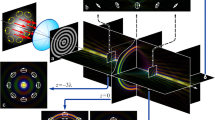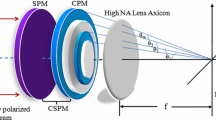Abstract
We consider the application of axicons in large-aperture focusing systems with different polarization. The aim is to increase the longitudinal extent of the focal spot and decrease its transversal size. Unlike conventional circular diaphragms, supplementing a high-aperture lens with an axicon is more efficient from the energetic point of view. The gain is proportional to the area of the masked part of the lens. Using an axicon we reduce the size of the central light spot from 0.51λ to 0.3λ for radial polarization. When we deal with linear polarization, which is the case for most laser beams, it is possible to produce a light spot narrowed in one direction to 0.32λ. For circular and azimuthal polarization it is efficient to use spiral axicons for producing compact distributions. When a large-aperture lens is supplemented even with a “weak” converging axicon, the focal area gets the conic form whose vertex has a smaller transverse dimension than the focal spot of a single lens. By choosing the axicon parameters we can vary the extent and “sharpness” of the cone. Moreover, by adding vortex phase we can control the contribution of different components of the electromagnetic field in the core and vertex of the cone. It can be useful in interaction of the electromagnetic field with the materials that have selective sensitivity to either longitudinal or transverse components of the field.
Similar content being viewed by others
References
Khonina, S.N., Ustinov, A.V., and Volotovsky, S.G., Fractional axicon as a new type of diffractive optical element with conical focal region, Precision Instrum. Mechanol., 2013, vol. 2, no. 4, pp. 132–143.
Koronkevich, V.P., Mikhaltsova, I.A., Churin, E.G., and Yurlov, Yu.I., Lensacon, Appl. Opt., 1993, vol. 34, no. 25, pp. 5761–5772.
Quabis, S., Dorn, R., Eberler, M., Glockl, O., and Leuchs, G., Focusing light to a tighter spot, Opt. Commun., 2000, vol. 179, pp. 1–7.
Youngworth, K.S. and Brown, T.G., Focusing of high numerical aperture cylindrical-vector beams, Opt. Express., 2000, vol. 7, pp. 77–87.
Dorn, R., Quabis, S., and Leuchs, G., Sharper focus for a radially polarized light beam, Phys. Rev. Lett., 2003, vol. 91, p. 233901.
Kozawa, Y. and Sato, S., Sharper focal spot formed by higher-order radially polarized laser beams, J. Opt. Soc. Am., Ser. A, 2007, vol. 24, p. 1793.
Rao, L., Pu, J., Chen, Z., and Yei, P., Focus shaping of cylindrically polarized vortex beams by a high numerical-aperture lens, Opt. Laser Technol., 2009, vol. 41, pp. 241–246.
Kotlyar, V.V. and Stafeev, S.S., Modeling the sharp focus of a radially polarized laser mode using a conical and a binary microaxicon, JOSA, Ser. B, 2010, vol. 27, no. 10, pp. 1991–1997.
Kalosha, V.P. and Golub, I., Toward the subdiffraction focusing limit of optical superresolution, Opt. Lett., 2007, vol. 32, pp. 3540–3542.
Davidson, N. and Bokor, N., High-numerical-aperture focusing of radially polarized doughnut beams with a parabolic mirror and a flat diffractive lens, Opt. Lett., 2004, vol. 29, pp. 1318–1320.
Stadler, J., Stanciu, C., Stupperich, C., and Meixner, A.J., Tighter focusing with a parabolic mirror, Opt. Lett., 2008, vol. 33, no. 7, pp. 681–683.
Zhan, Q., Cylindrical vector beams: from mathematical concepts to applications, Adv. Opt. Photon., 2009, vol. 1, pp. 1–57.
Wang, H., Shi, L., Lukyanchuk, B., Sheppard, C., and Chong, C.T., Creation of a needle of longitudinally polarized light in vacuum using binary optics, Nature Photon., 2008, vol. 2, pp. 501–505.
Sick, B., Hecht, B., and Novotny, L., Orientational imaging of single molecules by annular illumination, Phys. Rev. Lett., 2000, vol. 85, pp. 4482–4485.
Novotny, L., Beversluis, M.R., Youngworth, K.S., and Brown, T.G., Longitudinal field modes probed by single molecules, Phys. Rev. Lett., 2001, vol. 86, pp. 5251–5254.
Zhan, Q. and Leger, J.R., Focus shaping using cylindrical vector beams, Opt. Express., 2002, vol. 10, no. 7, pp. 324–331.
Kawauchi, H., Yonezawa, K., Kozawa, Y., and Sato, S., Calculation of optical trapping forces on a dielectric sphere in the ray optics regime produced by a radially polarized laser beam, Opt. Lett., 2007, vol. 32, p. 1839.
Romea, R.D. and Kimura, W.D., Modeling of inverse Cherenkov laser acceleration with axicon laser beam focusing, Phys. Rev., Ser. D, 1990, vol. 42, no. 5, p. 1807.
Gupta, D.N., Kant, N., Kim, D.E., and Suk, H., Electron acceleration to GeV energy by a radially polarized laser, Phys. Lett., Ser. A, 2007, vol. 368, pp. 402–407.
Beversluis, M.R., Novotny, L., and Stranick, S.J., Programmable vector point-spread function engineering, Opt. Express., 2006, vol. 14, pp. 2650–2656.
Yirmiyahu, Y., Niv, A., Biener, G., Kleiner, V., and Hasman, E., Excitation of a single hollow waveguide mode using inhomogeneous anisotropic subwavelength structures, Opt. Express., 2007, vol. 15, no. 20, pp. 13404–13414.
Xie, X.S. and Dunn, R.C., Probing single molecule dynamics, Science, 1994, vol. 265, pp. 361–364.
Khonina, S.N., Kotlyar, V.V., Soifer, V.A., Shinkaryev, M.V., and Uspleniev, G.V., Trochoson, Opt. Commun., 1992, vol. 91, no. 3–4, pp. 158–162.
Khonina, S.N., Kotlyar, V.V., Skidanov, R.V., Soifer, V.A., Jefimovs, K., Simonen, J., and Turunen, J., Rotation of microparticles with Bessel beams generated by diffractive elements, J. Mod. Opt., 2004, vol. 51, no. 14, pp. 2167–2184.
Zhan, Q., Properties of circularly polarized vortex beams, Opt. Lett., 2006, vol. 31, no. 7, pp. 867–869.
Khonina, S.N., Kazanskiy, N.L., and Volotovsky, S.G., Influence of vortex transmission phase function on intensity distribution in the focal area of high-aperture focusing system, Opt. Mem. Neural Networks (Inform. Opt.), 2011, vol. 20, no. 1, pp. 23–42.
Grosjean, T. and Courjon, D., Photopolymers as vectorial sensors of the electric eld, Opt. Express., 2006, vol. 14, no. 6, pp. 2203–2210.
Goodman, J.W., Introduction to Fourier Optics, New York: McGraw-Hill Book Company, Inc., 1968, p. 441.
Durnin, J., Exact solutions for nondiffracting beams, I: The scalar theory, J. Opt. Soc. Am., Ser. A, 1987, vol. 4, no. 4, pp. 651–654.
McLeod, J.H., The axicon: a new type of optical element, J. Opt. Soc. Am., 1954, vol. 44, pp. 592–597.
Fedotovsky, A. and Lehovec, H., Optical filter design for annular imaging, Appl. Opt., 1974, vol. 13, no. 12, pp. 2919–2923.
Richards, B. and Wolf, E., Electromagnetic diffraction in optical systems, II: Structure of the image eld in an aplanatic system, Proc. Royal Soc., Ser. A, 1959, vol. 253, pp. 358–379.
Helseth, L.E., Optical vortices in focal regions, Opt. Commun., 2004, vol. 229, pp. 85–91.
Wang, H. and Gan, F., High focal depth with a pure-phase apodizer, Appl. Opt., 2001, vol. 40, no. 31, pp. 5658–5662.
Author information
Authors and Affiliations
Corresponding author
About this article
Cite this article
Khonina, S.N., Volotovsky, S.G. Application axicons in a large-aperture focusing system. Opt. Mem. Neural Networks 23, 201–217 (2014). https://doi.org/10.3103/S1060992X14040043
Received:
Accepted:
Published:
Issue Date:
DOI: https://doi.org/10.3103/S1060992X14040043




